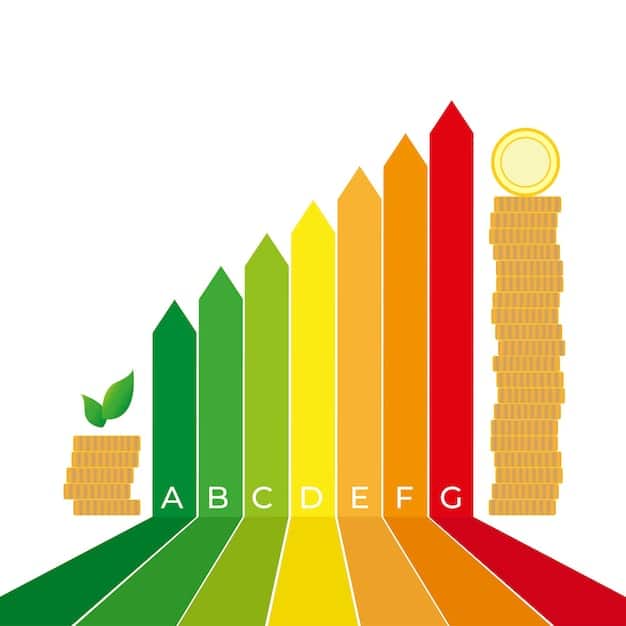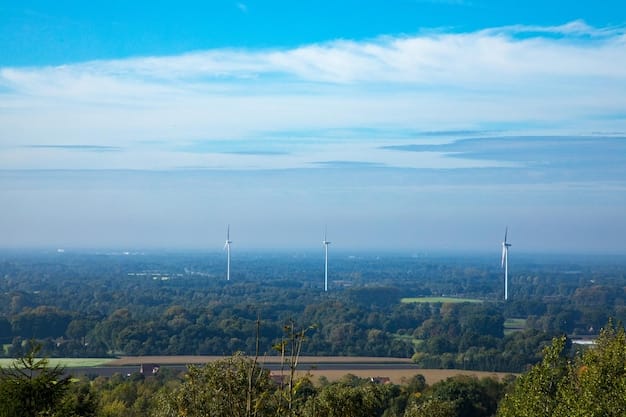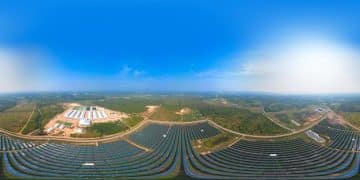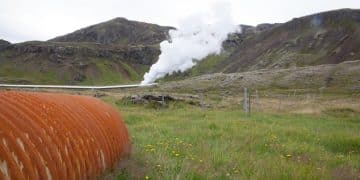Renewable Energy: Reduce Your Carbon Footprint and Save the Planet

Renewable energy sources offer significant environmental benefits, primarily by reducing carbon emissions and mitigating climate change, which is essential for creating a sustainable future.
Harnessing the power of renewable energy is a crucial step towards a sustainable future. By understanding the environmental benefits of renewable energy: reducing your carbon footprint, individuals and businesses can make informed choices that positively impact the planet.
Understanding Renewable Energy Sources
Renewable energy sources are naturally replenishing, unlike fossil fuels, which are finite. These sources include solar, wind, hydro, geothermal, and biomass. Understanding these sources is key to appreciating their environmental advantages.
What Makes Energy Renewable?
The term “renewable” means that the energy source is naturally replenished over a short period. This contrasts with fossil fuels, which take millions of years to form. This natural replenishment ensures a continuous supply of energy without depleting resources.
Types of Renewable Energy
- Solar Energy: Harnessing the sun’s power through photovoltaic cells or solar thermal systems.
- Wind Energy: Using wind turbines to convert kinetic energy into electricity.
- Hydropower: Generating electricity from the movement of water, such as rivers or dams.
- Geothermal Energy: Utilizing the Earth’s internal heat to generate electricity or for direct heating.
Understanding the different types of renewable energy is critical to evaluating their specific environmental benefits and how they can be implemented effectively. Each source has unique characteristics and applications, making them suitable for various geographical locations and energy needs.
The Core Environmental Benefits
The adoption of renewable energy offers a wide array of environmental benefits. From reducing greenhouse gas emissions to conserving natural resources, these advantages are essential for tackling climate change and promoting ecological well-being.

Reduced Greenhouse Gas Emissions
One of the most significant environmental benefits is the reduction in greenhouse gas emissions. Renewable energy sources produce little to no greenhouse gases during operation, helping to mitigate climate change.
- Lower Carbon Footprint: Decreasing the amount of carbon dioxide released into the atmosphere.
- Mitigating Climate Change: Reducing the impact of global warming and its effects.
- Cleaner Air: Less pollution from power plants, leading to improved air quality.
Transitioning to renewable energy is a direct and effective way to combat climate change. By minimizing greenhouse gas emissions, we can slow down global warming and protect ecosystems from the devastating effects of pollution. Cleaner air also contributes to public health, reducing respiratory illnesses and improving overall quality of life.
Conserving Natural Resources
Renewable energy sources conserve natural resources by reducing the reliance on fossil fuels. This helps protect ecosystems and ensures a sustainable supply of energy for future generations.
By shifting away from fossil fuels, we protect valuable ecosystems from destruction caused by mining and drilling operations. Conservation of natural resources is not just about preserving the environment but also ensuring that future generations have access to the resources they need to thrive.
Renewable Energy and Air Quality
The improvements in air quality resulting from the use of renewable energy are notable. By reducing air pollution, renewable energy sources contribute to better public health and healthier ecosystems.
Reduced Air Pollution
Renewable energy sources produce minimal air pollutants compared to fossil fuels. This leads to cleaner air and reduced respiratory illnesses.
Cleaner air benefits urban populations by reducing smog and improving visibility. The reduction in air pollution also has positive effects on ecosystems, preventing acid rain and other forms of environmental degradation.

Health Benefits
Improved air quality translates to significant health benefits. Reduced air pollution leads to fewer respiratory illnesses and a healthier population.
- Lower Rates of Asthma: Cleaner air can reduce the incidence of asthma and other respiratory conditions.
- Reduced Hospital Visits: Fewer pollution-related health issues mean fewer hospital admissions.
- Improved Overall Health: Cleaner air contributes to better cardiovascular health and overall well-being.
Investing in renewable energy is an investment in public health. The tangible benefits of cleaner air are felt in communities around the world, leading to more vibrant and healthy populations.
Water Conservation and Renewable Energy
Water conservation is another critical environmental benefit of certain renewable energy technologies. By reducing water consumption in energy production, renewable sources help preserve this vital resource.
Lower Water Usage
Many renewable energy technologies, such as solar and wind, require significantly less water than traditional fossil fuel-based power plants. This is especially important in regions facing water scarcity.
Traditional power plants often rely on large amounts of water for cooling, which can strain local water resources. Renewable energy sources reduce this demand, helping to conserve water and protect aquatic ecosystems. This lower water usage is a significant advantage in areas where water is scarce, making renewable energy a more sustainable option.
Protecting Aquatic Ecosystems
Reduced water usage helps protect aquatic ecosystems. Less water withdrawal means healthier rivers, lakes, and wetlands.
By minimizing the impact on water resources, renewable energy supports biodiversity and helps maintain the ecological balance of aquatic environments. Preserving these ecosystems ensures that they continue to provide essential services, such as clean water, flood control, and habitat for diverse species.
Land Use and Renewable Energy
Land use is an important consideration when evaluating the environmental impact of energy sources. While some renewable energy projects require land, the overall impact can be minimized with careful planning and implementation.
Efficient Land Use Strategies
Renewable energy projects can be designed to minimize land use. For example, solar panels can be installed on rooftops or in already disturbed areas. Wind farms can coexist with agricultural land.
Efficient land use strategies are essential for maximizing the benefits of renewable energy while minimizing environmental impacts. By integrating renewable energy projects into existing landscapes, we can reduce the need for new development and preserve valuable habitats.
Reduced Habitat Destruction
Compared to fossil fuel extraction, renewable energy projects generally result in less habitat destruction. This helps protect biodiversity and preserve natural landscapes.
Fossil fuel extraction often involves clearing large areas of land and disrupting ecosystems. Renewable energy projects have a smaller footprint and can be designed to minimize their impact on wildlife and natural habitats. This is crucial for preserving biodiversity and maintaining the health of ecosystems.
Economic Benefits Complementing Environmental Gains
The transition to renewable energy not only benefits the environment but also offers substantial economic advantages. These economic benefits can further drive the adoption of renewable energy and contribute to sustainable development.
Job Creation in the Renewable Sector
The renewable energy sector is a significant source of job creation. From manufacturing and installation to maintenance and research, the industry offers a wide range of employment opportunities.
Investing in renewable energy creates jobs in local communities and supports economic growth. These jobs are often in high-demand fields, such as engineering and technology, contributing to a skilled workforce and a thriving economy.
Reduced Energy Costs
Renewable energy can reduce energy costs over the long term. Once the initial investment is made, the energy source is essentially free, leading to lower operating costs.
The long-term cost savings of renewable energy make it an attractive option for both individuals and businesses. By reducing reliance on fossil fuels, we can insulate ourselves from volatile energy prices and create a more stable and affordable energy future.
| Key Point | Brief Description |
|---|---|
| ☀️ Reduced Emissions | Renewable energy lowers greenhouse gas emissions. |
| 💧 Water Conservation | Many renewable sources use less water. |
| 🌬️ Improved Air Quality | Cleaner energy leads to better air quality. |
| 🌎 Resource Preservation | Fewer fossil fuels means protecting natural resources. |
Frequently Asked Questions
The primary benefits include reducing greenhouse gas emissions, conserving natural resources, improving air quality, and reducing water consumption compared to fossil fuels.
Renewable energy sources produce little to no greenhouse gases during operation, thereby lowering our carbon footprint and helping to mitigate the effects of climate change.
Many renewable energy technologies, like solar and wind, use significantly less water than traditional fossil fuel-based power plants, conserving water resources.
Yes, renewable energy sources produce minimal air pollutants, leading to cleaner air and reduced respiratory illnesses, contributing to overall public health improvements.
Renewable energy projects generally result in less habitat destruction compared to fossil fuel extraction, especially when efficient land use strategies are employed.
Conclusion
Adopting renewable energy is crucial for a sustainable future. From reducing greenhouse gas emissions to conserving natural resources, the environmental benefits are clear. By understanding and embracing renewable energy, we can reduce our carbon footprint, protect the planet, and promote a healthier future for all.





